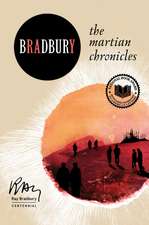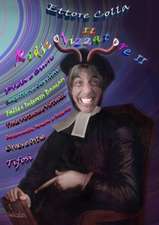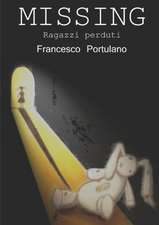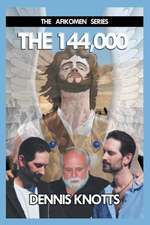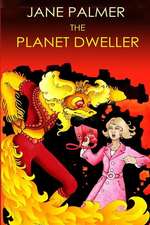A Canticle for Leibowitz
Autor Jr. Miller, Walter M.en Limba Engleză Paperback – 31 ian 1961
In a terrifying age of darkness and decay, these artifacts could be the keys to mankind's salvation. But as the mystery at the core of this groundbreaking novel unfolds, it is the search itself—for meaning, for truth, for love—that offers hope for humanity's rebirth from the ashes.
Preț: 55.61 lei
Nou
Puncte Express: 83
Preț estimativ în valută:
10.64€ • 11.07$ • 8.79£
10.64€ • 11.07$ • 8.79£
Carte disponibilă
Livrare economică 25 martie-08 aprilie
Livrare express 08-14 martie pentru 19.34 lei
Preluare comenzi: 021 569.72.76
Specificații
ISBN-13: 9780553273816
ISBN-10: 0553273817
Pagini: 338
Dimensiuni: 108 x 175 x 25 mm
Greutate: 0.18 kg
Ediția:Reissue
Editura: Spectra Books
ISBN-10: 0553273817
Pagini: 338
Dimensiuni: 108 x 175 x 25 mm
Greutate: 0.18 kg
Ediția:Reissue
Editura: Spectra Books
Notă biografică
Walter M. Miller, Jr. grew up in the American South and enlisted in the Army Air Corps a month after Pearl Harbor. He spent most of World War II as a radio operator and tail gunner, participating in more than fifty-five combat sorties, among them the controversial destruction of the Benedictine abbey at Monte Cassino, the oldest monastery in the Western world. Fifteen years later he wrote A Canticle for Leibowitz. The sequel, Saint Leibowitz and the Wild Horse Woman, followed after nearly forty years.
Extras
The box was shaped like a satchel and was obviously a carrying case of some kind. It might have served any number of purposes, but it had been rather badly battered by flying stones. Gingerly he worked it loose from the rubble and carried it closer to the fire. The lock seemed to be broken, but the lid had rusted shut. The box rattled when he shook it. It was not an obvious place to look for books or papers, but--obviously too--it was designed to be opened and closed, and might contain a scrap or two of information for the Memorabilia. Nevertheless, remembering the fate of Brother Boedullus and others, he sprinkled it with holy water before attempting to pry it open, and he handled the ancient relic as reverently as was possible while battering at its rusty hinges with a stone.
At last he broke the hinges, and the lid fell free. Small metal tidbits bounced from trays, spilled among the rocks, some of them falling irretrievably into crevices. But, in the bottom of the box in the space beneath the trays, he beheld--papers! After a quick prayer of thanksgiving, he regathered as many of the scattered tidbits as he could, and, after loosely replacing the lid, began climbing the hill of debris toward the stairwell and the thin patch of sky, with the box hugged tightly under one arm.
The sun was blinding after the darkness of the shelter. He scarcely bothered to notice that it was sinking dangerously low in the west, but began at once to search for a flat slab on which the contents of the box could be spread for examination without risk of losing anything in the sand.
Minutes later, seated on a cracked foundation slab, he began removing the tidbits of metal and glass that filled the trays. Most of them were small tubular things with a wire whisker at each end of each tube. These, he had seen before. The abbey's small museum had a few of them, of various size, shape and color. Once he had seen a shaman of the hill-pagan people wearing a string of them as a ceremonial necklace. The hill people thought of them as "parts of the body of the god"--of the fabled Machina analytica, hailed as the wisest of their gods. By swallowing one of them, a shaman could acquire "Infallibility," they said. He certainly acquired Indisputability that way, among his own people--unless he swallowed one of the poison kind. The similar tidbits in the museum were connected together too--not in the form of a necklace, but as a complex and rather disorderly maze in the bottom of a small metal box, exhibited as: "Radio Chassis: Application Uncertain."
Inside the lid of the carrying case, a note had been glued; the glue had powdered, the ink had faded, and the paper was so darkened by rusty stains that even good handwriting would have been hard enough to read, but this was written in a hasty scrawl. He studied it intermittently while emptying the trays. It seemed to be English, of a sort, but half an hour passed before he deciphered most of the message:
CARL--
Must grab plane for [undecipherable] in twenty minutes. For God's sake, keep Em there till we know if we're at war. Please! try to get her on the alternate list for the shelter. Can't get her a seat on my plane. Don't tell her why I sent her over with this box of junk, but try to keep her there till we know [undecipherable] at worst, one of the alternates not show.
I.E.L.
P.S. I put the seal on the lock and put TOP SECRET on the lid just to keep Em from looking inside. First tool box I happened to grab. Shove it in my locker or something.
The note seemed hasty gibberish to Brother Francis, who was at the moment too excited to concentrate on any single item more than the rest. After a final sneer at the notewriter's hasty scrawl, he began the task of removing the tray-racks to get at the papers in the bottom of the box. The trays were mounted on a swinging linkage which was obviously meant to swing the trays out of the box in stair-step array, but the pins were rusted fast, and Francis found it necessary to pry them out with a short steel tool from one of the tray compartments.
When Brother Francis had removed the last tray, he touched the papers reverently: only a handful of folded documents here, and yet a treasure; for they had escaped the angry flames of the Simplification, wherein even sacred writings had curled, blackened, and withered into smoke while ignorant mobs howled and hailed it a triumph. He handled the papers as one might handle holy things, shielding them from the wind with his habit, for all were brittle and cracked from age. There was a sheaf of rough sketches and diagrams. There were hand-scribbled notes, two large folded papers, and a small book entitled Memo.
First he examined the jotted notes. They were scrawled by the same hand that had written the note glued to the lid, and the penmanship was no less abominable. Pound pastrami, said one note, can kraut, six bagels--bring home for Emma. Another reminded: Remember--pick up Form 1040, Uncle Revenue. Another was only a column of figures with a circled total from which a second amount was subtracted and finally a percentage taken, followed by the word damn! Brother Francis checked the figures; he could find no fault with the abominable penman's arithmetic, at least, although he could deduce nothing about what the quantities might represent.
Memo, he handled with special reverence, because its title was suggestive of "Memorabilia." Before opening it, he crossed himself and murmured the Blessing of Texts. But the small book proved a disappointment. He had expected printed matter, but found only a handwritten list of names, places, numbers and dates. The dates ranged through the latter part of the fifth decade, and earlier part of the sixth decade, twentieth century. Again it was affirmed!--the contents of the shelter came from the twilight period of the Age of Enlightenment. An important discovery indeed.
Of the larger folded papers, one was tightly rolled as well, and it began to fall apart when he tried to unroll it; he could make out the words RACING FORM, but nothing more. After returning it to the box for later restorative work, he turned to the second folded document; its creases were so brittle that he dared inspect only a little of it, by parting the folds slightly and peering between them.
A diagram, it seemed, but--a diagram of white lines on dark paper!
Again he felt the thrill of discovery. It was clearly a blueprint!--and there was not a single original blueprint left at the abbey, but only inked facsimiles of several such prints. The originals had faded long ago from overexposure to light. Never before had Francis seen an original, although he had seen enough handpainted reproductions to recognize it as a blueprint, which, while stained and faded, remained legible after so many centuries because of the total darkness and low humidity in the shelter. He turned the document over--and felt brief fury. What idiot had desecrated the priceless paper? Someone had sketched absentminded geometrical figures and childish cartoon faces all over the back. What thoughtless vandal--
The anger passed after a moment's reflection. At the time of the deed, blueprints had probably been as common as weeds, and the owner of the box the probable culprit. He shielded the print from the sun with his own shadow while trying to unfold it further. In the lower right-hand corner was a printed rectangle containing, in simple block letters, various titles, dates, "patent numbers," reference numbers, and names. His eye traveled down the list until it encountered: "CIRCUIT DESIGN BY: Leibowitz, I.E."
He closed his eyes tightly and shook his head until it seemed to rattle. Then he looked again. There it was, quite plainly:
CIRCUIT DESIGN BY: Leibowitz, I.E.
The name was written in a clear feminine hand, not in the hasty scrawl of the other notes. He looked again at the initialed signature of the note in the lid of the box: I.E.L.--and again at "CIRCUIT DESIGN BY. . ." And the same initials appeared elsewhere throughout the notes.
There had been argument, all highly conjectural, about whether the beatified founder of the Order, if finally canonized, should be addressed as Saint Isaac or as Saint Edward. Some even favored Saint Leibowitz as the proper address, since the Beatus had, until the present, been referred to by his surname.
"Beate Leibowitz, ora pro me!" whispered Brother Francis. His hands were trembling so violently that they threatened to ruin the brittle documents.
He had uncovered relics of the Saint.
Excerpted from A Canticle for Leibowitz by Walter M. Miller, Jr. Copyright (c) 1959 by Walter M. Miller, Jr. Excerpted by permission of Bantam Books, a division of the Bantam Doubleday Dell Publishing Group, Inc. All rights reserved. No part of this excerpt may be reproduced or reprinted without permission in writing from the publisher.
From the Trade Paperback edition.
At last he broke the hinges, and the lid fell free. Small metal tidbits bounced from trays, spilled among the rocks, some of them falling irretrievably into crevices. But, in the bottom of the box in the space beneath the trays, he beheld--papers! After a quick prayer of thanksgiving, he regathered as many of the scattered tidbits as he could, and, after loosely replacing the lid, began climbing the hill of debris toward the stairwell and the thin patch of sky, with the box hugged tightly under one arm.
The sun was blinding after the darkness of the shelter. He scarcely bothered to notice that it was sinking dangerously low in the west, but began at once to search for a flat slab on which the contents of the box could be spread for examination without risk of losing anything in the sand.
Minutes later, seated on a cracked foundation slab, he began removing the tidbits of metal and glass that filled the trays. Most of them were small tubular things with a wire whisker at each end of each tube. These, he had seen before. The abbey's small museum had a few of them, of various size, shape and color. Once he had seen a shaman of the hill-pagan people wearing a string of them as a ceremonial necklace. The hill people thought of them as "parts of the body of the god"--of the fabled Machina analytica, hailed as the wisest of their gods. By swallowing one of them, a shaman could acquire "Infallibility," they said. He certainly acquired Indisputability that way, among his own people--unless he swallowed one of the poison kind. The similar tidbits in the museum were connected together too--not in the form of a necklace, but as a complex and rather disorderly maze in the bottom of a small metal box, exhibited as: "Radio Chassis: Application Uncertain."
Inside the lid of the carrying case, a note had been glued; the glue had powdered, the ink had faded, and the paper was so darkened by rusty stains that even good handwriting would have been hard enough to read, but this was written in a hasty scrawl. He studied it intermittently while emptying the trays. It seemed to be English, of a sort, but half an hour passed before he deciphered most of the message:
CARL--
Must grab plane for [undecipherable] in twenty minutes. For God's sake, keep Em there till we know if we're at war. Please! try to get her on the alternate list for the shelter. Can't get her a seat on my plane. Don't tell her why I sent her over with this box of junk, but try to keep her there till we know [undecipherable] at worst, one of the alternates not show.
I.E.L.
P.S. I put the seal on the lock and put TOP SECRET on the lid just to keep Em from looking inside. First tool box I happened to grab. Shove it in my locker or something.
The note seemed hasty gibberish to Brother Francis, who was at the moment too excited to concentrate on any single item more than the rest. After a final sneer at the notewriter's hasty scrawl, he began the task of removing the tray-racks to get at the papers in the bottom of the box. The trays were mounted on a swinging linkage which was obviously meant to swing the trays out of the box in stair-step array, but the pins were rusted fast, and Francis found it necessary to pry them out with a short steel tool from one of the tray compartments.
When Brother Francis had removed the last tray, he touched the papers reverently: only a handful of folded documents here, and yet a treasure; for they had escaped the angry flames of the Simplification, wherein even sacred writings had curled, blackened, and withered into smoke while ignorant mobs howled and hailed it a triumph. He handled the papers as one might handle holy things, shielding them from the wind with his habit, for all were brittle and cracked from age. There was a sheaf of rough sketches and diagrams. There were hand-scribbled notes, two large folded papers, and a small book entitled Memo.
First he examined the jotted notes. They were scrawled by the same hand that had written the note glued to the lid, and the penmanship was no less abominable. Pound pastrami, said one note, can kraut, six bagels--bring home for Emma. Another reminded: Remember--pick up Form 1040, Uncle Revenue. Another was only a column of figures with a circled total from which a second amount was subtracted and finally a percentage taken, followed by the word damn! Brother Francis checked the figures; he could find no fault with the abominable penman's arithmetic, at least, although he could deduce nothing about what the quantities might represent.
Memo, he handled with special reverence, because its title was suggestive of "Memorabilia." Before opening it, he crossed himself and murmured the Blessing of Texts. But the small book proved a disappointment. He had expected printed matter, but found only a handwritten list of names, places, numbers and dates. The dates ranged through the latter part of the fifth decade, and earlier part of the sixth decade, twentieth century. Again it was affirmed!--the contents of the shelter came from the twilight period of the Age of Enlightenment. An important discovery indeed.
Of the larger folded papers, one was tightly rolled as well, and it began to fall apart when he tried to unroll it; he could make out the words RACING FORM, but nothing more. After returning it to the box for later restorative work, he turned to the second folded document; its creases were so brittle that he dared inspect only a little of it, by parting the folds slightly and peering between them.
A diagram, it seemed, but--a diagram of white lines on dark paper!
Again he felt the thrill of discovery. It was clearly a blueprint!--and there was not a single original blueprint left at the abbey, but only inked facsimiles of several such prints. The originals had faded long ago from overexposure to light. Never before had Francis seen an original, although he had seen enough handpainted reproductions to recognize it as a blueprint, which, while stained and faded, remained legible after so many centuries because of the total darkness and low humidity in the shelter. He turned the document over--and felt brief fury. What idiot had desecrated the priceless paper? Someone had sketched absentminded geometrical figures and childish cartoon faces all over the back. What thoughtless vandal--
The anger passed after a moment's reflection. At the time of the deed, blueprints had probably been as common as weeds, and the owner of the box the probable culprit. He shielded the print from the sun with his own shadow while trying to unfold it further. In the lower right-hand corner was a printed rectangle containing, in simple block letters, various titles, dates, "patent numbers," reference numbers, and names. His eye traveled down the list until it encountered: "CIRCUIT DESIGN BY: Leibowitz, I.E."
He closed his eyes tightly and shook his head until it seemed to rattle. Then he looked again. There it was, quite plainly:
CIRCUIT DESIGN BY: Leibowitz, I.E.
The name was written in a clear feminine hand, not in the hasty scrawl of the other notes. He looked again at the initialed signature of the note in the lid of the box: I.E.L.--and again at "CIRCUIT DESIGN BY. . ." And the same initials appeared elsewhere throughout the notes.
There had been argument, all highly conjectural, about whether the beatified founder of the Order, if finally canonized, should be addressed as Saint Isaac or as Saint Edward. Some even favored Saint Leibowitz as the proper address, since the Beatus had, until the present, been referred to by his surname.
"Beate Leibowitz, ora pro me!" whispered Brother Francis. His hands were trembling so violently that they threatened to ruin the brittle documents.
He had uncovered relics of the Saint.
Excerpted from A Canticle for Leibowitz by Walter M. Miller, Jr. Copyright (c) 1959 by Walter M. Miller, Jr. Excerpted by permission of Bantam Books, a division of the Bantam Doubleday Dell Publishing Group, Inc. All rights reserved. No part of this excerpt may be reproduced or reprinted without permission in writing from the publisher.
From the Trade Paperback edition.
Recenzii
“Extraordinary ... chillingly effective.”— Time
“Angry, eloquent ... a terrific story.”— The New York Times
“An extraordinary novel ... Prodigiously imaginative, richly comic, terrifyingly grim, profound both intellectually and morally, and, above all ... simply such a memorable story as to stay with the reader for years.”— Chicago Tribune
“An exciting and imaginative story ... Unconditionally recommended.”— Library Journal
From the Trade Paperback edition.
“Angry, eloquent ... a terrific story.”— The New York Times
“An extraordinary novel ... Prodigiously imaginative, richly comic, terrifyingly grim, profound both intellectually and morally, and, above all ... simply such a memorable story as to stay with the reader for years.”— Chicago Tribune
“An exciting and imaginative story ... Unconditionally recommended.”— Library Journal
From the Trade Paperback edition.
Descriere
The winner of the 1961 Hugo Award for Best Novel, Miller's bestselling work is a true landmark of 20th-century literature--a chilling and still-provocative look at a post-apocalyptic future.

